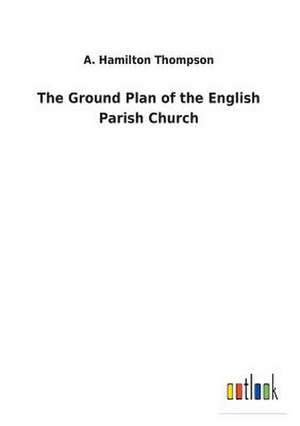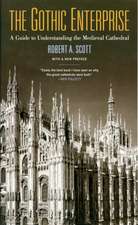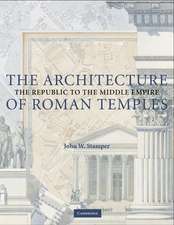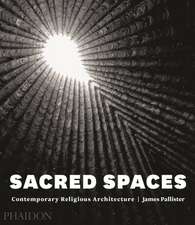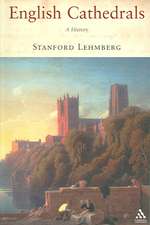The Ground Plan of the English Parish Church
Autor A. Hamilton Thompsonen Limba Engleză Paperback
| Toate formatele și edițiile | Preț | Express |
|---|---|---|
| Paperback (2) | 171.43 lei 3-5 săpt. | |
| – | 171.43 lei 3-5 săpt. | |
| Cambridge University Press – 10 aug 2011 | 203.50 lei 6-8 săpt. | |
| Hardback (1) | 323.38 lei 3-5 săpt. | |
| – | 323.38 lei 3-5 săpt. |
Preț: 171.43 lei
Nou
Puncte Express: 257
Preț estimativ în valută:
32.81€ • 35.62$ • 27.56£
32.81€ • 35.62$ • 27.56£
Carte disponibilă
Livrare economică 02-16 aprilie
Preluare comenzi: 021 569.72.76
Specificații
ISBN-13: 9783732629374
ISBN-10: 3732629376
Pagini: 94
Dimensiuni: 148 x 210 x 6 mm
Greutate: 0.13 kg
ISBN-10: 3732629376
Pagini: 94
Dimensiuni: 148 x 210 x 6 mm
Greutate: 0.13 kg
Cuprins
Preface; Part I. The Origin of the Church Plan in England: 1. The basilican church plan; 2. Problem of its derivation; 3. Rival theories of its origin; 4. The Roman basilica: old St Peter's; 5. Basilicas at Ravenna; 6. Tomb-churches and baptisteries; 7. Centralised plans at Ravenna; 8. Relative advantages of the basilican and the centralised plan; 9. The basilican church at Silchester; 10. Early churches in Kent and Essex; 11. Bradford-on-Avon, Wilts; 12. Escomb church, Durham; 13. Early Northumbrian churches; 14. Wilfrid's churches at Hexam and Ripon; 15. Brixworth, Northants: other basilican plans; 16. Brixworth, Northants: other basilican plans; 17. Exceptional occurrence of the basilican plan in England; Part II. Parish Churches of the Later Saxon Period: 18. The normal pre-Conquest plan; 19. The western bell-tower; 20. Plans in which the ground floor of the tower forms the body of the church; 21. Barton-on-Humber and the centralised plan; 22. Centralised planning in England; 23. The Saxon lateral porch; 24. Development of the transeptal chapel; 25. Towers between nave and chancel; 26. Development of the cruciform plan; 27. Development of the cruciform plan; 28. Influence of local material upon the aisleless church plan; Part III. The Aisleless Church of the Norman Period: 29. Survival and development of the aisleless plan after the Conquest; 30. The nave of the aisleless church; 31. Rectangular chancels; 32. Churches with no structural division between nave and chancel; 33. Churches with apsidal chancels; 34. The quire; 35. The transeptal chapel; 36. Cruciform plan: North Newbald and Melbourne; 37. Later developments of the cruciform plan; 38. Symbolism in planning; Part IV. The Aisled Parish Church; Section 1. Nave, Tower, and Porches: 39. Survival of the aisleless plan; 40. The addition of aisles; 41. The use of aisles for side altars; 42. Twelfth century aisled plans; 43. Ordinary method of adding aisles; 47. Raunds church, Northants; 48. Conservative feeling of the builders for old work; 49. Aisles widened and rebuilt; 50. Rebuilding of aisles as chantry chapels: Harringworth, Northants; 51. Newark, Cirencester, Northleach, and Grantham; 52. Naves lengthened westward; 53. The western tower in relation of the plan; 54. Engaged Western towers, etc.; 55. Rebuilding of towers; 56. Porches; 57. Position of the porch in the plan; Part V. The Aisled Parish Church; Section 2. Transepts and Chancel: 58. Cruciform churches with aisled transepts; 59. Addition of transeptal chapels; 60. Variety of treatment of transeptal chapels; 61. Transeptal chapels as a key to original ground plans; 62. Incomplete cruciform plans; 63. Irregular cruciform plans; 64. Central towers with transeptal chapels; 65. Transeptal towers; 66. Lengthening of chancels; 67. Encroachment of the chancel on the nave: Tansor; 68. Chancel chapels; 69. Churches with one chancel chapel; 70. Chantry chapels attached to chancels; 71. Effect of the addition of chapels on the cruciform plan; 72. The aisled rectangular plan; 73. Variations on the plan with aisled nave and chancel; 74. Development of the aisled rectangle at Grantham; 75. Deviation of the axis of the chancel; Index of places.
Descriere
Descriere de la o altă ediție sau format:
This 1911 book was the first to devote itself entirely to the historical development and resultant features of the parish church in England.
This 1911 book was the first to devote itself entirely to the historical development and resultant features of the parish church in England.
